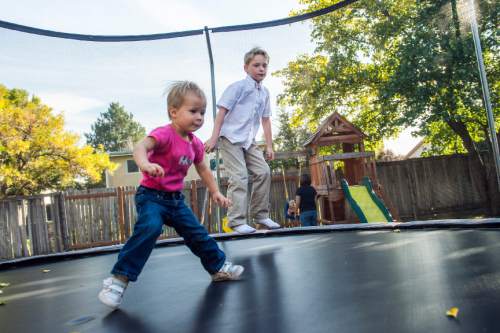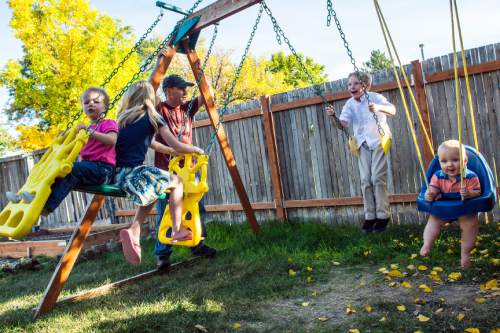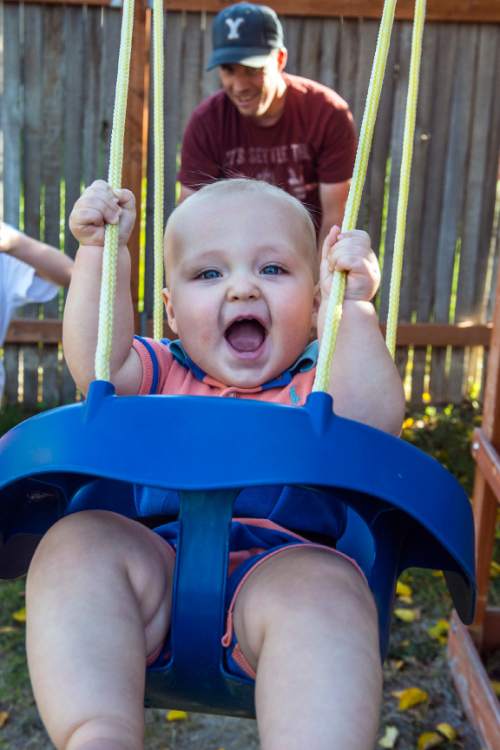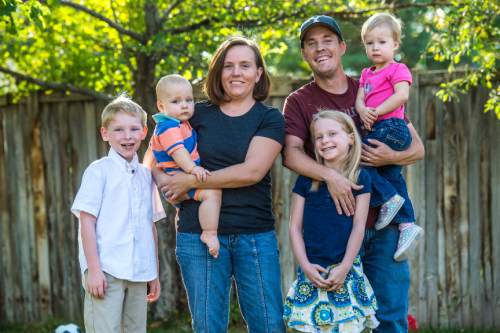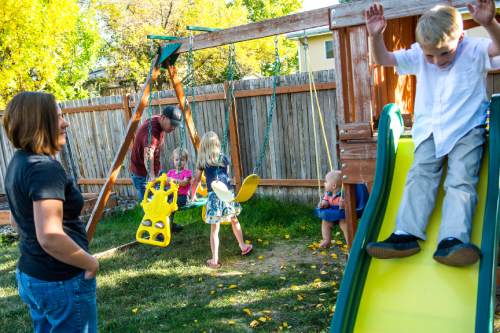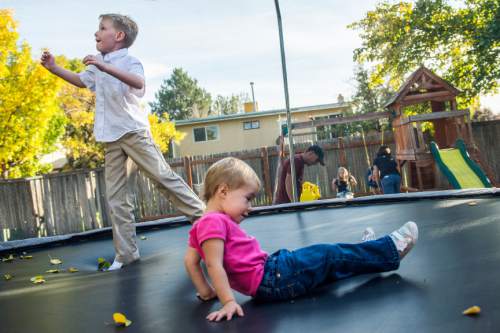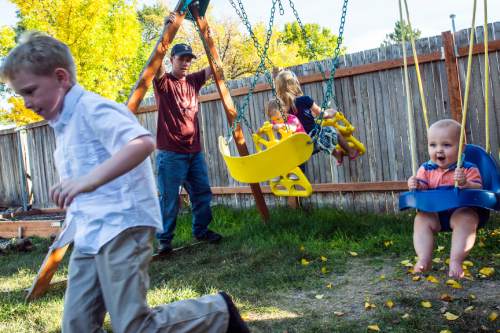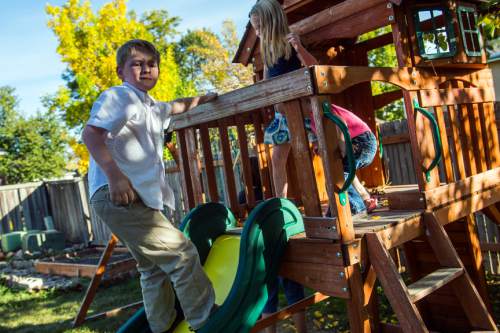This is an archived article that was published on sltrib.com in 2015, and information in the article may be outdated. It is provided only for personal research purposes and may not be reprinted.
During Tina Nelson's four pregnancies, she'd often tell people the baby wasn't her husband's.
And "it's not mine, either," she'd say.
It was a joke, but it was also true. Tina and her husband, Shayne Nelson, aren't genetically related to any of the four children she's given birth to. They're "snowflake babies," because they're unique, and were all adopted when they were just frozen embryos left over from another couple's in vitro fertilization.
The Nelsons have four children, from 17 total embryos over the course of nine years. Mara and Jacen are 8-year-old twins from the first embryo donation; Sara, 2, and Luke, 10 months, are from the third batch they received.
"We don't care where our children get their bodies or how they come, because it's all in Heavenly Father's hands," Tina said.
Couples who use in vitro fertilization often have "way more embryos than they'll end up using for their own family," said Kimberly Tyson, program director at Nightlight Christian Adoptions. While most couples in the United States either discard or donate their embryos to research, some couples choose to donate them to other families.
Adoption options • The Nelsons view their children as adopted — receiving donated embryos was different from a traditional adoption, they said, only in that it was successful.
Tina and Shayne, then 24 and 23 years old, tried to get pregnant soon after their marriage. But they learned Shayne had fertility problems, and that in vitro fertilization would not be an option for them, either.
The West Jordan couple tried domestic adoption, international adoption and foster care, but for six years were met with repeated heartbreak as each fell through.
"We would talk to our adoption agency, and they would say there's someone looking at us. We'd get all excited thinking we were getting a baby and it would fall through — and it was like we had lost a baby," Tina said.
Then, Tina heard about embryo "adoption." The couple was open to "anything and everything," she said, and in 2006, turned to Nightlight Christian Adoptions.
The agency treats embryo adoptions like traditional ones — couples donate their embryos and then choose another family to be recipients.
The Nelsons were required to complete a home study program. Potential donor families reviewed their lengthy profile and background. They also had to be Christian — a potential stumbling block for out-of-state families who might be wary of the couple's Mormon faith.
After just three months, though, the Nelsons were selected by a donor family in another state and adopted eight embryos. But it was only the beginning.
Embryos have to be transported and then thawed.
The fight to actually get pregnant then ensues. In order to simulate pregnancy, Tina had to take hormone shots three times a day for weeks leading up to the procedure placing the embryos in her body — an incredibly painful process, she said.
A few days after the first embryos were implanted, the couple found out Tina was pregnant with twins.
They were elated. Though the process was difficult, it was worth it, and they went through it four more times. All five embryos from the second set were unsuccessful, but their third set resulted in two pregnancies.
The biggest difference between an embryo adoption and a traditional adoption is "you get to be pregnant," Tyson said. "For a lot of women, that is the attraction of embryo adoption."
But calling the process "adoption" is problematic, some doctors say.
Snowflake siblings • According to the American Society for Reproductive Medicine, using the term "adoption" is "deceptive, because it reinforces a conceptualization of the embryo as a fully entitled legal being." But embryos are not "beings," ASRM said, and do not have personhood under United States law.
The Utah Fertility Center, for example, performs embryo donations for their patients, but doesn't call it adoption. And it's all done anonymously.
Dr. Keith Blauer of the Utah Reproductive Care Center said he has one patient in Idaho Falls who used the embryo of a couple in their neighborhood, and the relationship remains an open one.
"I think creating life from embryos is special. It's a special thing when people are willing to help other people have a child," Blauer said. "One of our first patients who was successful from a donor embryo is a little boy, 10 years old. Every time I see him it melts my heart. ... You'd never know he doesn't have a genetic connection to Mom and Dad."
Nightlight recommends that families do keep the relationship between genetic child and parents open, and serves as a mediator in those arrangements.
One family who used Nightlight's services lives in Oregon, but was matched with a donor in Virginia. The two families have regular communication and even vacation together, Tyson said.
Potentially, the Nelson kids — two sets of biological siblings — have full genetic siblings elsewhere, but they don't have a relationship with their genetic families.
Tina and Shayne said the older kids know they're "snowflake" babies, and their baby books have pictures of them as embryos. "They've always known that another mom and dad helped us make them," Tina said. But the Nelsons wanted a closed adoption.
"In my mind frame, they were our kids," Tina said. "We were very grateful to [the biological parents] ... but it's our family."
One benefit of embryo "adoption" is "you don't have the risk of the birth mother wanting to have her baby back or rejecting the adoption match," Tyson said.
That may be true now, but in 2008, the Nelsons had a different experience. Their first "adopted" batch had eight embryos, two of which became Jacen and Mara, their 8-year-old twins, and two that didn't survive the thawing process. That left them with four.
But contracts back then lasted only a year, and the biological parents of the embryos chose not to renew the contract. The Nelsons, in turn, lost the four embryos.
Now, the contracts have firmed up, and biological parents cannot change their minds about the embryos they've donated.
Plenty of questions • Though implanting a donated embryo is a fraction of the average price of an IVF procedure, which is upward of $25,000, new parents can still face plenty of costs.
The Utah Fertility Center charges about $4,000 to implant an embryo. Nightlight's embryo adoption service is about $14,000.
And storing extra embryos can cost a couple in the U.S. $400 to $1,000 a year. The Utah Fertility Center and the Reproductive Care Center in Sandy both charge about $500 annually.
In the United Kingdom, fertility treatments are largely paid for by the government, so most couples don't have to decide between destroying, donating or paying to store their embryos, said Dr. Shawn Gurtcheff of the Utah Fertility Center. But the country does struggle with how to store them all.
A 2011 survey found that there are more than 600,000 frozen embryos in storage in the United States, and Tyson said that the number is closer to 1 million.
The majority of those are being held for future use by the families that created them. The U.S. Department of Health and Human Services estimates that 60,000 of the frozen embryos could be used for adoption, and has spent $26 million since 2002 to fund awareness campaigns about embryo donation.
Estimating the exact number of embryos in storage in Utah is difficult. There are at least three clinics in the state that facilitate embryo donation, but they store embryos by patient and say they don't keep a count of the number of embryos each patient has in storage.
But it's not common in Utah for families to have extra embryos, doctors say.
"We have lots and lots of couples who would love to receive a donated embryo," Gurtcheff said. "We have a lot fewer who have extra embryos that they're not planning to use."
Many couples in the Beehive State want larger families and so use what other couples might consider "extra" embryos, Gurtcheff said.
"We don't have thousands of embryos sitting abandoned," Blauer said. "We have a lot of embryos in storage, but a lot of them are waiting for a couple years between kids before they have the next one."
Others are uncomfortable with donating.
"A lot of people are a little bit uneasy with having their biological children out there somewhere, not knowing whether they made babies," Blauer said.
Blauer's top recommendation to patients is to donate their unused embryos to other couples. But in the clinic's 10-year history, he said, less than 5 percent of couples have chosen to do so.
Adam and Angie Grundvig are grappling now with the decision of what to do with their frozen embryos. The couple welcomed twin boys last month from in vitro fertilization, and still have five of their embryos. The cost of storage is not insignificant, Adam said, but that concern pales compared to the unknowns.
The couple decided not to discard the embryos in case they want to have more children, but they've also considered donating. They would prefer to donate to a couple they know rather than anonymously, but many questions still loom, Adam said.
If the couple were able to donate embryos to friends and they brought home a baby, would the baby look like Grundvigs' twins? And would they want to share that connection with their children?
"Frankly, these are really hard questions that we didn't think about when we started in vitro," Adam said. "We understood our chances of having a baby were very low, so we thought we would need all seven of our embryos. Only after we became pregnant with twins did we ask, 'What do we do with our other five?' "


